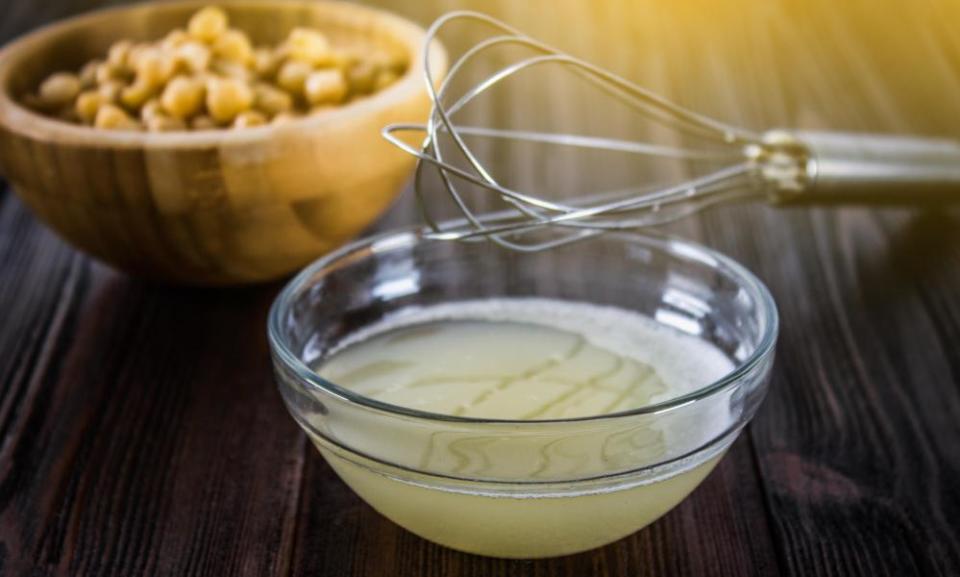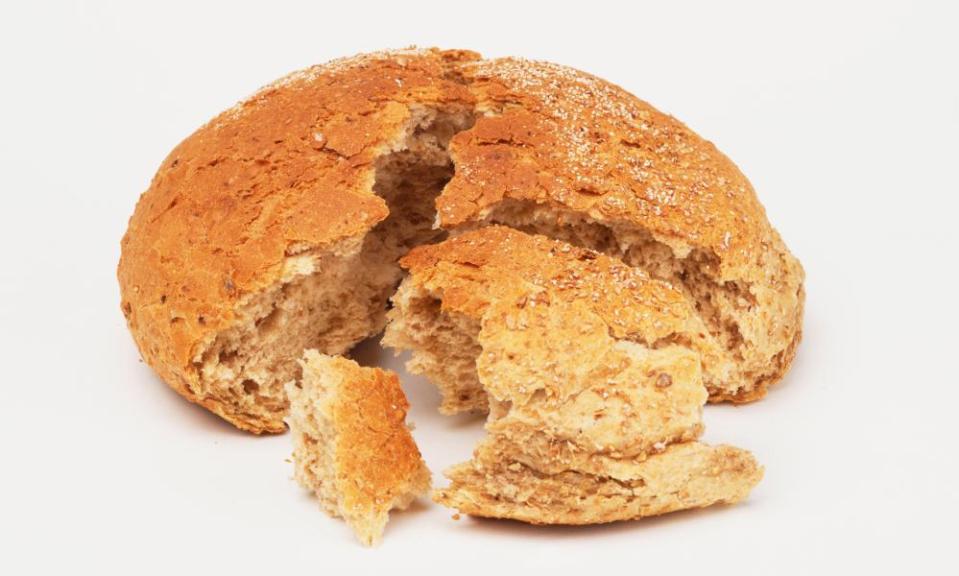No flour, pasta or eggs? The perfect substitutes for 20 common ingredients

Like life itself, cooking at home is likely to change radically in the coming months. It will be a sanctuary for some and a chore for others, but in an era of lockdowns, we will all sometimes be frustrated by not having this or that ingredient to hand – and no longer being able to pop out to get it. How you work around that lack of ingredients may determine how well you eat in 2020. To help, we asked various chefs and expert foodies – the kind of people who improvise every day – for their tips on how to best substitute in and swap out key ingredients while still creating delicious meals.
Salt
The simple substitute, reckons Louis Korovilas, the executive head chef at Tavolino in central London, is “digging out a crushed stock cube from the back of the cupboard”. Alternatively, suggests Stuart Ralston, the chef-owner of Noto and Aizle in Edinburgh: “Soy sauce is a direct replacement that gives better flavour.” Ralston would use soy in everything from stews to, if pushed, a white sauce for fish: “Right now, I can’t think of any broad rule of: ‘It can’t go in X.’ Go ahead.”
Tom Cenci, the chef at the Loyal Tavern in south-east London, flags up salty staple ingredients such as capers, parmesan and anchovies, while Aktar Islam, from Opheem in Birmingham, recommends the brine from tinned pulses: “There’s a Bajan recipe I do that uses lentils. I never season it, because I just pour the brine in, while cooking the lentils.”
Mitshel Ibrahim, the head chef at Ombra in east London, says: “If it’s something you’ve been busy with in quarantine, most lacto-fermented vegetables have a good amount of salt. They can be added to stews or sauces if you’re looking for a multilayered addition of acidity, salt and funk.”
But do you need salt? “I learned from the chef Olivier Roellinger that spices can create a richer flavour profile,” says Apollonia Poilâne, the CEO of the French bakery Poilâne. “I never suggest salt and pepper in recipes, but rather spice.”
Butter
“You can substitute most fats for other fats. You can make biscuits with vegetable or olive oil. Cheaper neutral oils are best. Fancy olive oil would make it a bit funky,” says Ralston.
Lemons
A few drops of vinegar will lend the required acidic edge to sauces and salads, while Ottolenghi lovers should double-check their spice drawers. “If you’re lucky, you may have some sumac you can substitute,” says Paolo Saba, the executive chef at Madera in central London.
Given that oranges, lemons and limes go off fairly quickly in the fridge, Richard De La Cruz, the head chef at Arros QD in central London, recommends freezing the juice in ice cube moulds in the freezer, “ready to be used when needed”. Esther Miglio, the chef-owner of OWT in Leeds, zests all her lemon rinds, freezes this citrus snow and uses it “to season as you would salt and pepper. Freeze the zest on baking parchment and, once dry, place into a sealed bag. It’ll last six months.”
Mayonnaise
“UHT soy milk is not just for millennial lattes,” says Alex Claridge from The Wilderness in Birmingham. “It can be stick-blended into a mayo using vinegar and rapeseed or sunflower oil (125ml soy milk, two teaspoons vinegar, 250ml oil, seasoning). I think I speak for the majority when I say dips are going to be a pivotal part of isolation cuisine and, if you add miso paste, it’s pretty compelling.”
Cooking wine
“You can use any alcohol to deglaze pans or make a stew. I’ll be saving my wine for drinking, so I may be experimenting heavily with those dusty bottles in the back of the cupboard,” says Sven-Hanson Britt from Oxeye in central London. “I’m 100% confident that ‘chicken à la Baileys’ is going to be delicious.”
In braises, stews and ragouts, Gizzi Erskine, the food writer and chef at The Nitery in central London, would replace wine with a gastrique. “It’s a technique of acidulating caramelised sugar to boost the balance of sweet and sour umami in a dish. I do a shortcut at home of one tablespoon of sugar melted into two tablespoons of vinegar. I use sherry vinegar, but use whatever you have. Reduce that down to about one tablespoon of syrup and add it to the dish. It’s amazing something simple can do so much.”
Flour

Most baking requires flour. But if you are using it to thicken a soup or a sauce, you have options. “Adding a few slices of potato during cooking helps thicken a stew,” says Ryan Blackburn, the chef at the Old Stamp House in Ambleside, Cumbria. As does rice, says Saba: “Grind it into powder in a food processor and substitute.”
Si Toft, the chef-owner at The Dining Room in Abersoch, Gwynedd, has a more 70s suggestion: “I’ll get chucked out of chefs club for this, but Smash is quality. Use it instead of flour to hold fish cakes or thicken a sauce. It’s basically tasteless. Disclaimer: I don’t use Smash at work. I use gluten-free flour, which is just trendy Smash.”
For a béchamel, says Britt, use “dry bread crusts, biscuits, crackers or anything of that ilk and crush them into a fine powder”, then mix that with butter to create a roux.
More generally, do not waste bread, advises Rachel Stockley, the chef at Baraxturi in Ramsbottom, near Bury: “It can be stretched out as breadcrumbs for topping oven bakes or as croutons to bulk out salads. I like to blend torn stale bread into soups to thicken them, like our garlic soup. It is four main ingredients: chicken stock, a garlic bulb, bread, olive oil.”
Cheese
“In dire times,” says Claridge, “umami-rich yeast flakes provide a passable substitute for parmesan cheese in sauces, and as a topping.”
Vinegar
Britt recommends retaining and/or repurposing liquid from a jar of something pickled, such as ginger or cornichons: “Even high-acidity apple juice will do a similar job to vinegar in your cooking.” Kombucha fans may be interested to know, says Ibrahim, that, by using a scoby (a fermentation-starting combination of bacteria and yeast), “you can quite easily turn an unfinished bottle of wine into vinegar.”
Sugar
“You can use maple syrup, honey or golden syrup pretty much anywhere you’d find sugar,” says Ralston. You could also use waste syrup from tinned fruit, intensify sweetness in desserts by adding a pinch of cinnamon (a tip from Lina Stores’ head chef, Masha Rener), or deploy vegetables with a higher sugar content (parsnips, beetroots, carrots, sweet potatoes, courgette) in your baking as a way to build in sweetness. This will take trial and error, however. As Poilâne points out: “Generally, you can halve the sugar content of recipes without affecting their chemical balance.”
Rice
“Look for alternatives: ancient grains and pulses such as pearl barley, buckwheat, bulgur wheat, millet and lentils,” advises Irina Georgescu, the author of the cookbook Carpathia.
Fresh garlic
Chefs used to shudder at the very idea of using dried garlic granules. A man made for these febrile times, Toft takes a more pragmatic line: “At home, where we don’t get through the same quantity, dried garlic is brilliant. Also, I have a bottle of oil I’ve been topping up since about 1997 that’s got a load of leftover garlic cloves in it. I use it when I’m browning meat, rather than messing around with fresh garlic.”
Meat
Without getting bogged down in the effectiveness or, in this crisis, the availability of meat substitutes (tofu, jackfruit etc), what you certainly can do with dishes in the cottage-pie-to-ragout sphere is bulk out what meat you have. “You could go Scottish and stretch ground meat with oats and suet,” says the chef Nina Matsunaga, from the Black Bull in Sedbergh, Cumbria. “Or mince or dice any veg and mix it through.”
Toft suggests lengthening bolognese sauce with bread: “I put Marmite through mine at home, because I prefer the flavour over stock cubes, so do that as well. It won’t fool [the renowned Italian chef] Massimo Bottura, but it’s tasty and packed with vitamins.”
Barley, chickpeas and lentils will do a similar job – or, says Claridge, go full vegan: “With the world increasingly dark, it was only a matter of time before you had to summon seitan. Add it to curries and stews. It’s tinned and, I guarantee, avoided most panic-buying lists.”
Pesto
“At work, I make a pesto every day from blanched kale, parsley stalks, pumpkin seeds and garlic oil. It’s beautiful and basically free,” says Toft. Georgescu is also a kale pesto fan: “There’s no cheese needed and it can be used on top of soups, pasta, bread and eggs.”
Pasta
The shortage of spaghetti has made the idea of using a spiraliser to craft courgetti or other vegetable noodles less a “clean eating” fashion statement and more a necessity. If you crave the real thing, says Officina 00’s chef Elia Sebregondi, you can make a rudimentary pasta, such as the tiny, Sugar Puff-shaped cavatelli, with flour and water: “Use some semolina flour, which has a lot more protein and nutritional value.”
“For a little more deliciousness,” says Britt, “make some fresh spätzle or eastern European-style hand-cut noodles, which cook like pasta.” You will need eggs and some patience; for a primer, see Felicity Cloake’s How to cook the perfect … on the subject.
Potatoes
“Other big root vegetables can work as well, such as celeriac or swede, and can often offer better flavour,” says Cenci. Britt, who points out that spuds will keep for months if left in the dark in a sack or other breathable, dry container, agrees: “Roasted jerusalem artichokes, swede boulangère or carrot and cauliflower mash all give you that comforting texture and, arguably, have more flavour.”
Stock cubes
“In a chicken tray bake or a casserole, beer is a great alternative. It often brings more flavour – certainly richness and sweetness,” says Stockley. Matsunaga takes a similar but alcohol-free approach: “At home, if we have no fresh stock, we use Marmite, Worcestershire sauce, miso or tomato puree to add umami.”
Eggs
Will the aquafaba cult now cross over? Chefs love the viscous water that tinned chickpeas sit in and its ability to double as egg whites. “Two tablespoons equals one egg; a 400g can is the equivalent of six egg whites,” enthuses Ricky Evans, the executive chef at Milroy’s in London. Toft is another convert: “I’m not going to pretend to understand the science, but I do vegan meringues whisked to peaks, 100g of sugar to a tin’s worth of liquid, and they’re pretty good.”
Google can provide you with numerous other replacements for eggs in baking, from milk to fruit purees, depending on how you are using them (leavening agent, binding etc). “Most people don’t know you can make a beautiful egg-free cake,” says Roberta d’Elia, the head chef at the meal-delivery company Pasta Evangelists. Use 50ml of milk or 70g of plain yoghurt to replace the moisture one egg would normally impart.
Interestingly, adds Ibrahim, pigs’ blood “coagulates in a very similar way to eggs”.
Sour cream

“In a food processor, blend a handful of cashew nuts, the juice of a lemon, sea salt and a few tablespoons of water until super-smooth. You won’t believe how it resembles sour cream,” says Saba.
Onion
“If I don’t have onions, I always use bacon. The taste is very similar when you cook it until crispy,” says D’Elia.
Flavour enhancers
If herbs become scarce, spice racks run low and you are out of the usual enhancers (anchovies, soy, Marmite etc), there are novel ways to punch up flavour. “I vouch for celery salt to boost umami in almost anything,” says Erskine. Ben Tish, of Norma in central London, rates brown sauce or ketchup as “concentrated replacements for wine, vinegar and salt in ragouts and stews. They contain an array of spices, have bags of flavour and depth, and they also add colour, particularly brown sauce, if you are short on gravy granules.”
More challenging is Ibrahim’s frugal suggestion of saving whey from bagged mozzarella, bringing it to a rapid boil, then simmering it until it caramelises: “The result is a punchy, acidic elixir with a very strong, meaty taste that can be used as a flavour enhancer.”

